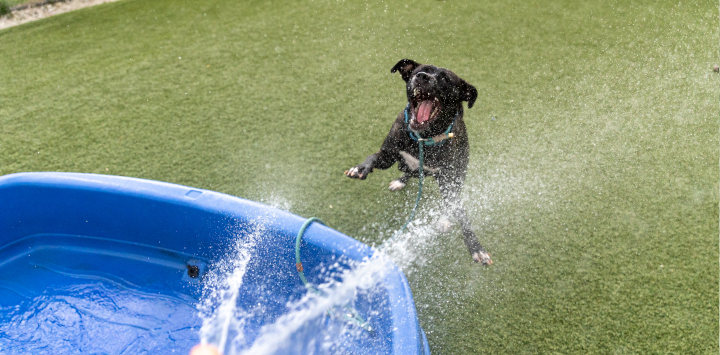
Photo pros share tricks of the trade
January 10th, 2023
A picture is worth a thousand words. It’s a universal truth that exists across generations and cultures, one so ingrained in the way we perceive the world that it’s hard to even pin down who first coined the phrase. Google it, and some will swear it came from advertising executive Frederick R. Barnard, while others attribute it to playwright Henrik Ibsen. Or was it newspaper editor Arthur Brisbane who came up with the truism? And those are just the Americans cited as the phrase’s originator.
Regardless of who first made the observation, it’s one to bear in mind when trying to engage the public with the work of animal welfare – especially our efforts to find fosters or adopters. Research has even shown that dogs get adopted more quickly if they are promoted with good photographs. In fact, the nonprofit organization HeARTs Speak collected data around this topic in 2018 and found:
- Dogs who appear happy in photos are most likely to be considered for adoption, while photos of dogs who seem neutral or sad are not likely to sway someone either toward or against adoption.
- The most important types of photos used to make decisions are those that clearly show a dog’s face, full body and personality.
- 65% of adopters look at photos of dogs online before adopting, and nine out of 10 adopters use such photos to compare the dogs they are considering adding to their households.
- Finally, 64% of adopters said online photos are “extremely or very important” factors in their decision to adopt.
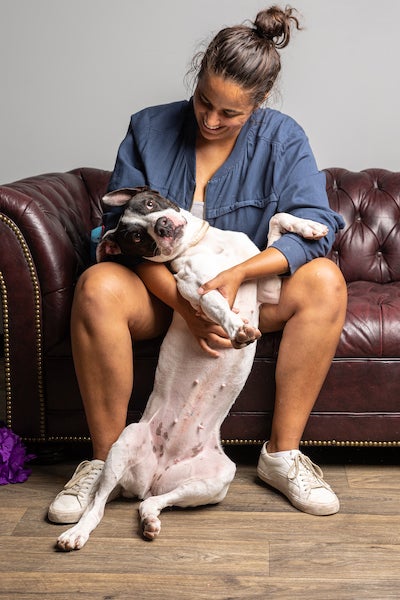
Right now, you’re probably thinking: “Great! So, we just need to get amazing photos of the hundreds (or thousands) of animals we accept every month? No problem. We’ll get right on that…”
That’s where an organization like HeARTs Speak comes in. Knowing full well that shelters and rescues are swamped with day-to-day duties, and that many of them might not have access to individuals with photography skills, the organization was founded to fill that niche. HeARTs Speak’s mission is to give shelters access to everything from photography and marketing workshops to a global network of 500+ artists, primarily photographers, who collectively provide more than 20,000 hours of creative services each month.
Two such network members – Ohio-based Robyn White and Pennsylvania-based Carol Arscott – spoke with us about their work helping shelters market their animals. They also shared some pro tips that even the most inexperienced photographer can use to get dogs and cats moving out of shelters and into homes.
Once the amateur's naive approach and humble willingness to learn fades away, the creative spirit of good photography dies with it. Every professional should remain always in his heart an amateur
— Photographer and photojournalist Alfred Eisenstaedt
While both Robyn and Carol make their living taking photos today, that wasn’t the case when they began snapping pictures of shelter animals some years ago. Robyn was a volunteer dog walker with City Dogs, the adoption arm of the City of Cleveland Animal Care and Control, five years ago when another photographer at the shelter suggested she take pictures. Carol found her path to taking photos of adoptable animals when her oldest son had to do community service work as a requirement for graduation.
“We found a rescue that wanted someone to come in and play with the cats,” Carol says. “He loves cats but wasn't old enough to go by himself, so I went with him and started taking photos, which the group liked enough to post them on social media. Once they saw those photos resulted in increased adoption rates, they asked me to do more.”
Neither woman has given up providing services on a volunteer basis, either. Dog photography is a major part of Robyn’s business today, but she still volunteers her time with City Dogs as well as other rescue in the area whenever she can. And Carol continues to help rescue groups by taking photos of those dogs who are hardest to adopt. She also recently started a Facebook group called Rescue for Rescues to share photography advice, answer questions and help rescuers raise money.
Odds are good that your organization already has an amateur shutterbug in its midst. Is there someone who is already taking great pictures on their cell phone? If so, that’s talent in the raw and there are plenty of free resources available on HeARTs Speak as well as all over YouTube to help them hone their craft. (While still staying “an amateur at heart” like Alfred Eisenstaedt said, of course.)
The best camera is the one that’s with you
— Photographer, director and fine artist Chase Jarvis
Speaking of cell phones, both Robyn and Carol are vehement that good photos don’t require access to expensive professional equipment.
“It is absolutely possible to get great photographs with cell phones, especially the more recent models,” Robyn says. “A City Dogs volunteer even developed a guidebook for taking better cell phone photos that she patterned off the HeARTs Speak cell phone photography guide.”
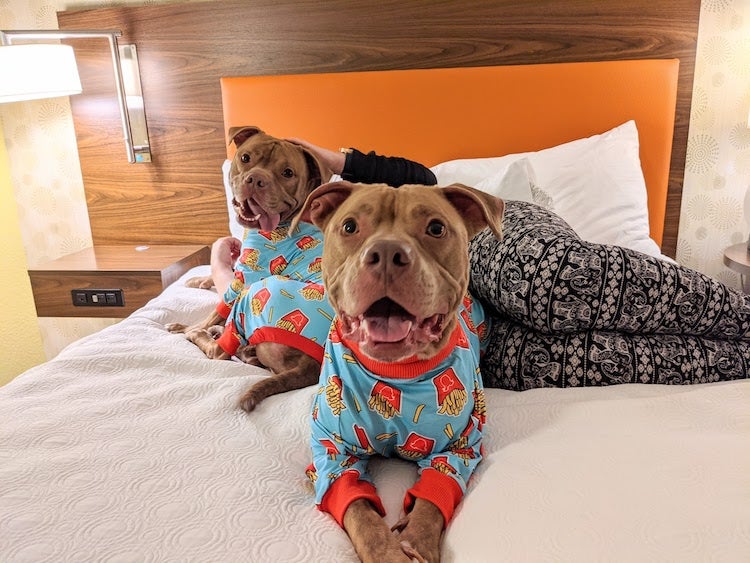
Sometimes, cell phone cameras turn out photos that are even better than those taken with pricey, top-of-the-line tools. Take the case of Niles and Frasier. Robyn and another volunteer took the bonded pair for an overnight in a hotel and did a photoshoot of them wearing matching jammies.
“I actually brought my pro camera, but the lighting was too bad, so I abandoned it in favor of my cell phone,” she says. “Their images got picked up by People.com and shared through Facebook thousands of times, and they were adopted together the day after People.com picked up the story. I love stories like Niles and Frasier’s because it shows that you don't have to have fancy images to get the public's attention.”
If, however, your organization is trying to get photos in a print publication, then a cell phone will not capture images with a high-enough resolution. That’s when a digital single-lens reflex (DSLR) camera and professional lighting can come in handy. Even so, if you don’t have access to those tools, there’s another way to get such high-quality shots: remotely via the Shutter App, which Carol has been using to help support shelters and rescues outside of her area.
“Clients download the app to their phone or iPad and I can control it from my computer,” Carol says. “I direct them how to hold the phone, where to stand, how to position the dog. The results are not the same quality I would get with a high-end DSLR, but they are remarkable considering that I'm hundreds or possibly thousands of miles away. I can work with rescuers basically anywhere in the world. It's a game changer.”
Wherever there is light, one can photograph
— Photographer and art dealer Alfred Stieglitz
Whether you use a cell phone, high-end DSLR or the Shutter app, lighting can make or break the result. No matter where you are taking photos, the goal is to position the animal under soft, even light. If you’re shooting indoors – where artificial lighting can cause unpleasant color tones – set up in a well-lit room close to a window draped with a sheer curtain. If you’re shooting outside – which is far preferable – try to do so in the early morning hours, or at the end of day an hour or so before sunset.
As an example of how much lighting can impact the quality of a photo, Carol compares two images of a black-and-white poodle mix that were taken two minutes apart.
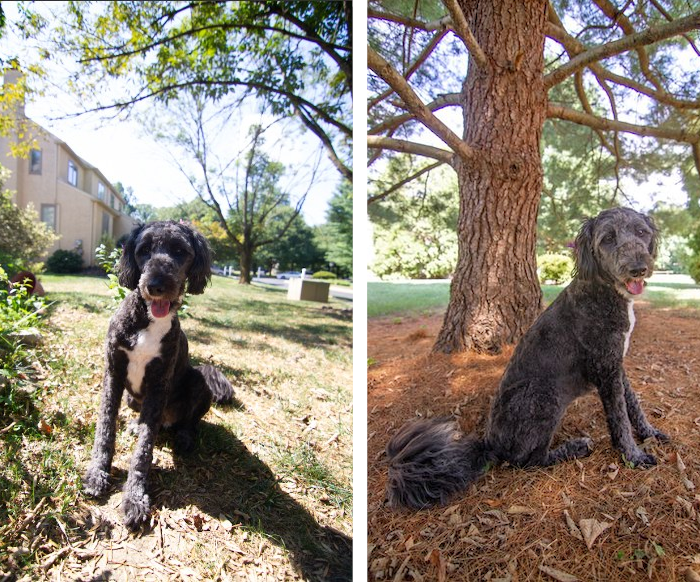
“The one on the left was taken right outside my front door. See how the light on Oreo is uneven? What color is she? Who knows. You can't see any detail in her face, she has shadows on her chest, and her legs are blown out,” she says. “For the second image, we walked across the street, and I positioned her under a tree. You can tell what color she is now. The light is even, and you can see the details in her face.”
She also explains how Oreo’s surroundings impact how effective the photos are.
“The eye tends to read a photo from top to bottom and left to right,” she adds. “In the first shot, my neighbor's house and the giant utility box by the street draw your eye away from Oreo. In the second photo, your eye is drawn directly to her naturally by the lines of the tree, plus there are minimal background distractions.”
If your shelter or rescue has gotten into the habit of taking dogs into the alley and photographing them in front of the trash cans, it’s time to find a different spot.
“Even if you can walk away a bit and position the dog in front of some trees or a large rock, that will add a little bit of visual interest while not being too distracting,” Carol says.
If your pictures aren’t good enough, you’re not close enough
— War photographer and photojournalist Robert Capa
If you are not able to move into a better environment, take extreme close-ups. Get close enough to cut out all background distractions and fill the entire frame with the animal’s face. Don’t be afraid to get down to the animal’s level, either.
“I recommend either sitting low or laying down,” Carol says. “Alternately, if you can put the animal up on a table or chair and have them look down into the camera, that is a super cute pose. Especially if they tilt their head; those are great.”
Converting the photo to black and white likewise can eliminate a lot of background distractions.
“Black and white will focus your attention on the animal,” Carol says. “You don't often see pictures of dogs in black and white, so that can help them stand out.”
Lastly, do a mix of vertical and horizontal shots. Online articles like those on the Best Friends website, for example, always lead with an image at the top of the page that needs to be a horizontal orientation.
Cats never strike a pose that isn’t photogenic
— American writer Lillian Jackson Braun
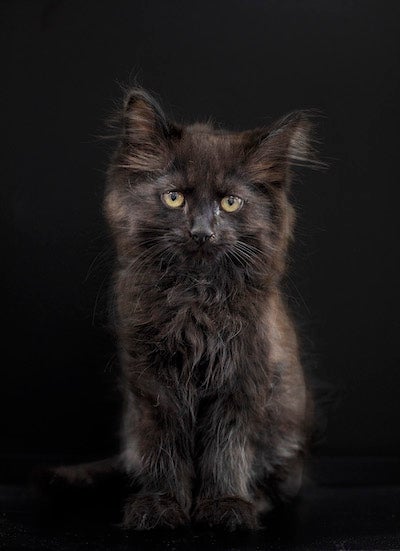
Despite what Lillian Jackson Braun says, many animal photographers will tell you that cats are really hard to take good pictures of.
“There have been times when I've had to photograph cats in the litter box because they were frightened and wouldn’t come out,” Carol says. “Again, my advice is to zoom in as much as you can. If you have an assistant, especially someone the cat is comfortable with, have them pull out one of the cat’s favorite toys. I’ve gotten some really cute pictures of cats reaching out to swat feathers or other toys.”
Even better, letting the cat have room to move around will generate a lot of interesting images and go a long way toward capturing the feline personality.
“I worked with one rescue that was able to take their cats out of the cages and let them wander around the room,” Carol says. “I gave the cats time to get comfortable and just followed them, waiting for them to do their thing. For cats who are really scared, try putting them inside a cat tree. They feel safe and protected in there and you can get some adorable pictures of them sticking their head out of the openings.”
It’s one thing to make a picture of what a person looks like, it’s another thing to make a portrait of who they are
— Landscape photographer Paul Caponigro
Lighting, background, composition – all these things are important. What makes a photo really successful, however, is if it captures the true spirit of the animal. While there are many ways to achieve this goal, it’s critical to give each animal the time they need to decompress from the shock of being in the shelter before you start taking photos. Once a dog or cat has a chance to relax a bit, then you can consider how best to show off who they are.
“These images should inspire people to want to learn more about who these animals are,” Carol says. “That's really the key.”
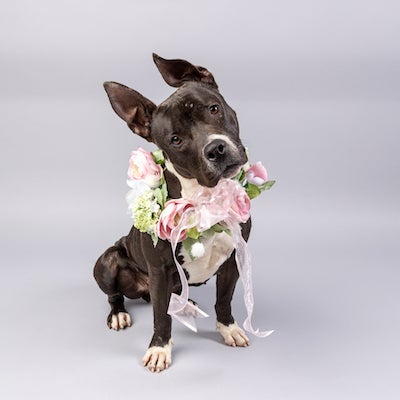
Especially if she is taking headshot-type images in a makeshift studio set up at the shelter, Robyn uses an extensive wardrobe of shirts, bows, ties, bandanas, pajamas, etc., to show off their personality.
“A black dog named Freya was at the kennel for six months, and she was very sweet,” she says. “People often overlook black animals, though. I took pictures of her wearing a flower wreath, and her adopters said those images made them want to meet her. After they adopted Freya, they even contacted me and purchased a number of those images.”
Potential adopters should be able to imagine what it would be like to have a dog or cat as part of their family. So, in addition to getting great solo images, make a point of taking photos of cats and dogs interacting with people or other animals. Both Carol and Robyn regularly make use of shelter play yards for photo shoots. They also enlist volunteers to help.
“If it's possible, have a volunteer take the dog out for exercise before the photo session even starts,” Carol says. “That will burn off extra energy and help calm them so they're not barking or jumping. Plus, a tired dog is much easier to photograph than one who just woke up.”
Give the dog time to acclimate to what's going on, which includes letting them smell you and your equipment, meet new people, and be properly introduced to any other animals who are present.
“Sometimes that takes five minutes, sometimes it takes 25 minutes,” Carol says. “The big thing to remember is don't try to get them to conform. This is not a person having a portrait session. It's not somebody that can take direction from you. You really have to let the animal call the shots.”
Once the photo session starts, Carol’s rule of thumb is “make it fun.”
“Throw a ball and take a picture of the dog bringing the ball back. Take a picture of them laying in the grass, playing with a stick,” she says. “Do something that helps people imagine what it would be like to have that dog in their life, that will make them think, ‘Oh, I would love to play ball with that dog.’
Finally, have patience.
“A lot of times I will just position myself and wait for the dog to do what I want it to do,” Carol adds. “I don't try to force the dog to do anything. I let him do his thing and when the time is right, I take the picture.”
Results are uncertain even among the more experienced photographers
— Civil War photographer Matthew Brady
Mastering any new skill is all about trial and error, and not getting discouraged. Sure, you may take 34 photos in one session that are totally unusable. If number 35 turns out fantastic and even gets that dog or cat adopted, however, then that’s success. Certainly, neither Robyn nor Carol would be where they are today if they had just given up – and the thousands of animals they’ve helped find new homes through their photos might not have had such happy outcomes, either.
“I took one photography class in college and my professor basically told me to put down the camera because I didn’t have what it takes,” Carol says. “I would find a way to work my parents’ dog or my rabbits into every assignment and he hated that. He finally said I wasn’t cut out for photography.
“I would love to be able to track him down now that I’m a professional photographer,” she adds. “Maybe I didn't do well with the assignments, but I was photographing what I loved. I think that's what really makes the difference. When you do what you love, that's where the magic happens.”

Liz Finch
Senior Writer
Best Friends Network
If you enjoyed this program spotlight, you can find our complete catalog of spotlights here.